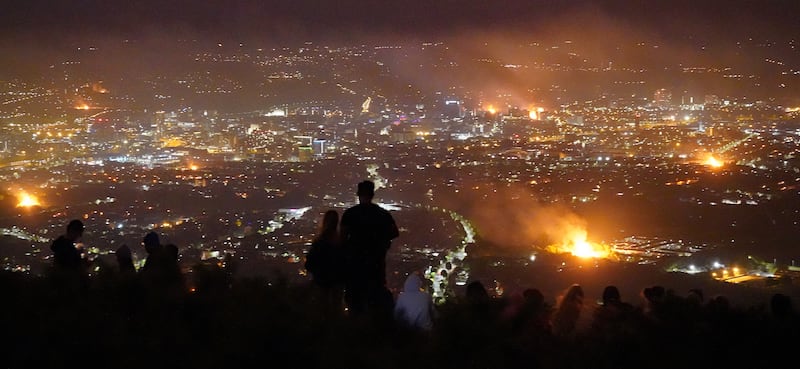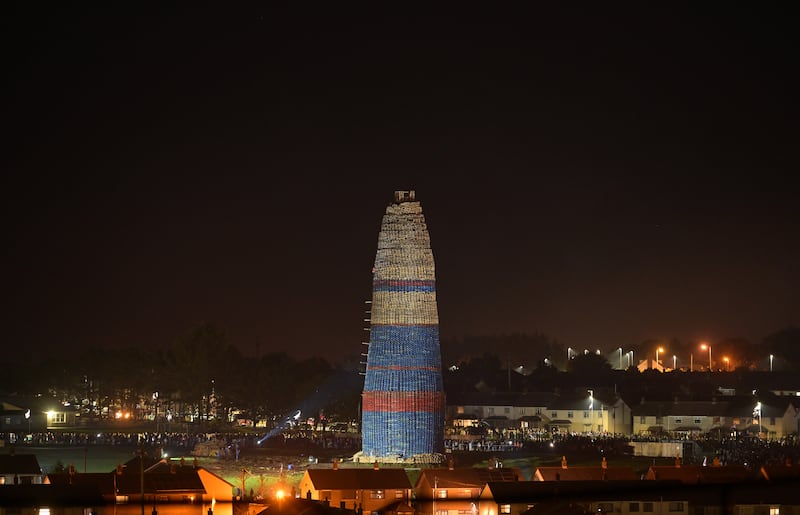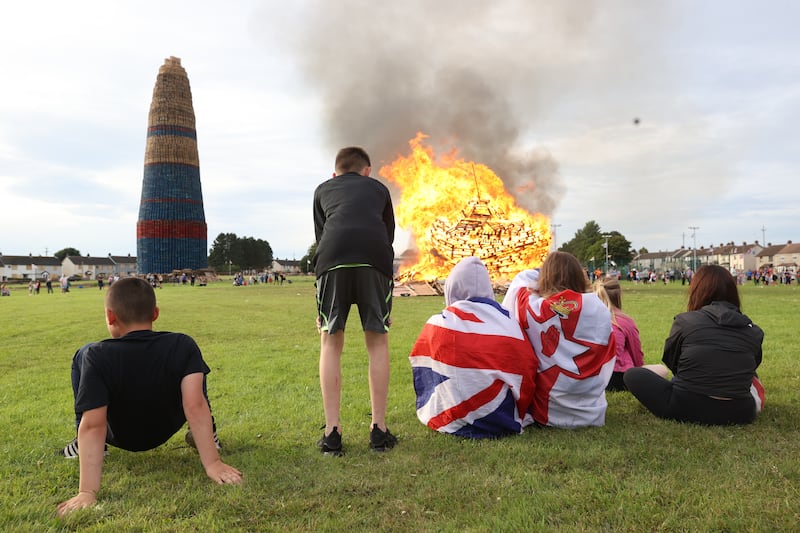Some 332 years after King William of Orange vanquished the forces of Catholic King James, the social media users of Belfast have been rushing to judgment not on the “Battle of the Boyne”, but on the “Battle of the Bins”, a short-lived altercation between a young nationalist and a loyalist marching band in the “Holylands” area of south Belfast.
Phone footage taken from across the road, complete with a suitably expletive laden commentary from shocked women onlookers, shows a man emerging from the front door of a house and hurling a green recycling bin at the passing “Bangor Protestant Boys” flute band on the morning of the Twelfth.
The man swiftly retreats into the house, from which an Irish tricolour is flying, banging the front door shut in the face of the angry bandsmen. The bandsmen then pick up another bin and smash the front window of the building into which he has disappeared.

It is an indication of how important the media is to the message in Northern Ireland that, within minutes of the incident, different edited versions of the video were being circulated — one omitting the initial bin hurling, another editing out the band’s enraged response and yet another telling the full story.
READ MORE
The Agincourt Avenue affair also featured a subplot as the police — who most agree acted swiftly to contain the original skirmish — were videoed taking into custody, not the green bin lobbed at the band, but the black one used to smash the window.
Then followed a letter from loyalist Jamie Bryson condemning the bin hurling as an “unprovoked sectarian attack”, but also offering the band’s apologies and compensation to the “entirely innocent” resident of the ground floor flat whose window was smashed, yet who had nothing to do with the original bin bombardment.
There have been many attempts to make the Eleventh Night more of a family friendly occasion with entertainment and fireworks alongside the use of smaller beacons
The “Battle of the Bins” may have provided an element of farce to what most acknowledged was a largely trouble-free return of the Twelfth, after a couple of years in which the Covid pandemic had forced the Orange Order to constrain their annual parades.
However, alongside the farce came a truly tragic incident as a 36-year-old father of two, John Steele, fell to his death whilst working on the construction of an Eleventh Night bonfire on the outskirts of Larne last weekend.
The phrase “accident waiting to happen” may come to mind when contemplating the chances of a mishap in the construction of such massive edifices, without any official oversight or regulation. John Steele was apparently an experienced bonfire builder, yet as the pyres get higher the risks are obvious.
[ Council opens investigation into death of man in fall from bonfire in LarneOpens in new window ]
Every Eleventh Night the emergency services in Northern Ireland warn about the dangers. Last summer a teenager suffered critical burns while trying to use a petrol container to ignite a bonfire in north Belfast. But the importance of the tradition to those involved was underlined by a message from John Steele’s grieving family to the bonfire builders in another Larne estate, Craigyhill.
The Steele family urged the Craigyhill builders not to give up on their world record attempt to construct a fire more than 200 feet tall. In the event, whilst Mr Steele’s ill-fated construction was dismantled by diggers brought in by the local council, the Craigyhill blaze went ahead in his honour, its builders dedicating their extraordinary creation to his memory. The 202-foot pyre burned for 25 minutes before toppling to the ground.

When I was first dispatched to cover Eleventh Night as a young BBC reporter in the 1980s, I remember being taken aback by the size of the Belfast bonfires. As an Englishman brought up amid November 5th Bonfire Night celebrations, the concept wasn’t unfamiliar, but the scale most certainly was.
Like Guy Fawkes Night, the loyalist Eleventh Night bonfires have their roots in the religious conflicts of the 17th century, harking back to beacons lit on the hills of Antrim to welcome King William’s forces as they marched from Carrickfergus towards Belfast. Over the years, lighting the “bone-fire” or “boney” became every loyalist community’s warm-up act for the next day’s Twelfth parades.
In a recent BBC Radio Ulster discussion, the evangelical Protestant Wallace Thompson reminisced about a time when hymns were sung and sermons preached beside the fires, but even he admitted this may have been a “rose-tinted” memory.
Maybe his rural and my urban experiences contrasted. In the 1980s and 90s, I recall the city bonfires as often accompanied by lots of alcohol. During the Troubles, they sometimes provided the backdrop to paramilitary shows of strength. The fire service’s presence might be tolerated at the margins to douse down neighbouring homes at risk of catching alight, but woe betide the firefighter who turned their hose on the actual cause of the incendiary danger.
Ulster University lecturer Jonny Byrne told the BBC’s Talkback programme he thinks there are now fewer but larger Eleventh Night fires. Dr Byrne puts the tendency of loyalist communities to erect bigger and bigger fires down to social media. They can easily inspect the progress of constructions in competing housing estates, often photographed from every angle, given the widespread availability of drone footage.
Wallace Thompson likens this year’s immense pyres of pallets, often put in place with the assistance of cranes, to Tower of Babel-type constructions. He argues that loyalists have drifted away from their traditional values and advocates a shift back to smaller community events, closer to the original history of the 17th century Williamite beacons.
Bonfire builders have — with some success — been urged not to burn toxic materials, like old tyres, and encouraged to use more sustainable fuel such as willow which is sometimes encased in metal cages or modern “beacons”. Earlier this year, Belfast City Council advertised a range of grants varying between £25,000 (€30,000) and £100,000 (€118,000) for organisations promising to “engage with issues relating to positive cultural expression” in the lead up to and around July 11th and August 8th (the anniversary of internment) through the provision of “summer community diversionary festival activity ... at specific locations where there are negative issues associated with bonfires”.
Certainly there have been many attempts to make the Eleventh Night more of a family friendly occasion with entertainment and fireworks alongside the use of smaller beacons. The DUP Lagan Valley MLA Emma Little-Pengelly posted photos of herself and her party leader, Jeffrey Donaldson, attending just such a fun day in their constituency, complete with a bouncy castle. Ms Little-Pengelly described the Twelfth as being about “family, community and identity, faith and values”.
“Like most cultural celebrations, it pertains to a particular group, identity and history,” she said. “That is not unusual — in fact, that is exactly what celebrating identity and heritage is and why there are protections.” The barrister-turned-politician also defended the bonfire tradition, arguing that “despite those who are naysayers, bonfires and pyres have been part and parcel of human existence for 1000s of years.
Effigies of Alliance leader Naomi Long, together with Sinn Féin’s Mary Lou McDonald and Michelle O’Neill, were hung from a bonfire in Carrickfergus
“They are part of community commemoration, celebration and marking of big events. Stop the navel gazing..start to recognise these hugely historical traditions.”
However, a contrasting perspective was provided by the academic Dr Laura McAtackney, who specialises in archaeology and heritage. “We need to recognise that to publicly celebrate a partial and contentious heritage is positive for those included, but conversely negative for those excluded,” Dr McAtackney responded. “When it is framed by bonfires burning identifiers of the other, this exclusion is reinforced.”
Dr McAtackney said that “to pretend that the Twelfth doesn’t exist within a networked tradition of violent imposition of its ‘rights’ and hostile rejection of the identity of the excluded is gross misrepresentation. The Twelfth is not inherently bad, but in its current form, it is a problematic heritage”. Pointing to the future, she concluded: “To end on a positive note, heritage is not a static entity. It is constantly changing and in most cases is capable of opening up as well as closing down. The Twelfth is entwined with a history of sectional identity, power and privilege but its future is, as yet, undecided.”
It is hard to reconcile the perspectives of those who regard the Eleventh Night bonfires as one of Europe’s great enduring folk traditions which should be encouraged and reimagined as a part of an inclusive “Orangefest” with critics who point out that the burning of Irish tricolours and images of opponents, together with the display of sectarian signs such as KAT (kill all Taigs) would simply not be tolerated anywhere else.
This week, the Alliance leader Naomi Long complained that the regular burning of the election posters of nationalist and middle ground candidates had been taken another stage further when effigies of herself, together with Sinn Féin’s Mary Lou McDonald and Michelle O’Neill, were hung from a bonfire in Carrickfergus.
Ms Long says those images made her feel “physically sick ... not just at the effigies but at the festering hatred and sectarianism they represent; hatred that not only persists in our community but is being passed on to the next generation as normal”.

The Ulster Unionist leader Doug Beattie — already on record condemning the burning of Irish tricolours and election posters — sympathised with Ms Long’s outrage, arguing that “hanging effigies on bonfires does not represent the union and unionist culture I believe in. Staying silent is not an option”.
Although the issues raised by bonfire safety and sectarian hatred are distinct, the difficulty in adequately resolving them is related. Both raise the question of whether bonfires are cultural traditions which can be sensibly regulated by the Northern Ireland authorities or acts of community and political defiance, which render the combined forces of the police, fire service, local councils and statutory agencies extraordinarily reluctant to intervene.
Dr Jonny Byrne says some bonfire builders regard any talk of “regulation” as tantamount to “eradication” of their tradition. However, if there continues to be no rules for the Eleventh Night pyres, there has to be real concern that this year’s tragic death of John Steele won’t be the last.
In December 2021, Stormont published a report from a Commission on Flags, Identity, Culture and Tradition which recognised bonfires as “a legitimate form of celebration or commemoration” and suggested builders should consult the fire service on the height and location of their constructions and refrain from “the burning of any flag, emblem, election poster or any other image or item which could cause offence”. It sounds sensible, however there is no clue as to when or whether the recommendations from the report — which itself cost £800,000 (€944,583) — will be implemented.
If there is a silver lining to the attention given to south Belfast’s “Battle of the Bins”, it has to be that the commentary devoted to it underlines the welcome fact that this year’s Twelfth did not lead to any more serious street confrontations elsewhere. The continuing display of offensive materials on bonfires needs to be tackled, but the caution demonstrated by the police on this score is understandable given the lack of any political consensus and the recent history of confrontations when enforcement action has been taken against either Eleventh Night or nationalist internment anniversary pyres.
One impressive feature about the Craigyhill tower burned in John Steele’s memory was not just its height, but the fact that it was not adorned by any offending flags, election posters or effigies. There is no denying the image of the 202-foot pyre being set alight, accompanied by a firework display, did inspire a certain sense of awe.
At the time of writing, the builders are still waiting for Guinness World Records to verify their achievement. However, it would be positive if more of Northern Ireland’s bonfire builders could return to their old “beacon” tradition and belatedly discover the maxim that “small is beautiful”.
















